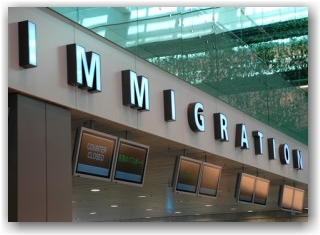Posts Tagged ‘DOS’
Thursday, October 15th, 2015
 Stakeholders are outraged by the most recent development with the so-called streamlining of the allocation of immigrant visas that are published monthly in the Department of State’s (DOS) Visa Bulletin.
Stakeholders are outraged by the most recent development with the so-called streamlining of the allocation of immigrant visas that are published monthly in the Department of State’s (DOS) Visa Bulletin.
Unless otherwise indicated on the USCIS website at www.uscis.gov/visabulletininfo,
individuals seeking to file applications for adjustment of status with USCIS in the Department of Homeland Security must use the “Application Final Action Dates” charts in the Visa Bulletin for determining when they can file such applications. When USCIS determines that there are more immigrant visas available for the fiscal year than there are known applicants for such visas, USCIS will state on its website that applicants may instead use the “Dates for Filing Visa Applications” charts in the Bulletin. The USCIS website statement is supposed to be posted within one week of the Visa Bulletin publish date.
Applicants for adjustment of status may refer to USCIS for additional information by visiting www.uscis.gov/visabulletininfo. USCIS has indicated on their website (above link) that that you may use the Dates for Filing Visa Applications chart for the corrected October 2015 and November 2015 Visa Bulletins.
Something has absolutely got to change here. This has reached a level of complete and utter absurdity.
Refer here for November filing date information.
For background information on this issue, refer here
Tags: adjustment of status, Department Of Homeland Security (DHS), DOS, Immigrant Visa Allocation, Immigration News, Permanent Residency Applications, USCIS, visa bulletin, Visa Gate
Posted in Department Of Homeland Security (DHS), Department of State, Immigrant Visas (I-140 Petitions), Immigration News, USCIS | Comments Off on DOS/USCIS’ Lame Attempt at ‘streamlining'(?) the Immigrant Visa Process
Wednesday, January 22nd, 2014
 If you Previously had an H-1B for Less than 6 Years
If you Previously had an H-1B for Less than 6 Years
Pursuant to § 212(g)7) of the The Act, if you had an H-1B in the past and were in the USA for less than 6 years, you may be eligible to recoup the time that is remaining on the 6-year maximum period of stay to accept employment with a new employer – without being counted against the cap. An example of this would be someone who works for 3 years in H-1B classification and decides to go back to school on an F-1 student visa. This individual would be eligible to apply for an H-1B for the remaining 3 years at any time of the year.
If you are abroad for at least one year, you have the choice to either apply for a “new” cap H-1B for a full 6-year period, or take advantage of the remainder option if you previously had an H-1B.
H-1B 7th Year Extensions – How This Works
If you are the beneficiary of a labor certification or an I-140 petition that was filed 1 year prior to your 6th year in H-1B status, pursuant to §106 of AC21, you are permitted to file for a 7th year extension. You are also permitted, according to §104(c) of AC21, to apply for a 3-year extension of your H-1B when you have an approved I-140 petition and are unable to move forward with filing your permanent residency case due to employment-based immigrant visa country limits (referred to as retrogression).
If you are in the US and out of status due to a layoff, or are abroad, you are entitled to a 7th year extension of your H-1B if your labor certification or I-140 petition was filed before your 6th year in H-1B status with either the sponsoring employer, or with a new employer. You will more than likely be required to consular process your case in these scenarios.
It is recommended that you seek the advice of a skilled immigration professional with the above cases as they are complex in nature.
You can sign up to receive our information here
Tags: Cap-Exempt, DOL, DOS, H-1B, H-1B 7th Year, H-1B Cap, LCA, Remainder Option, Specialty Occupation, USCIS
Posted in Department Of Labor (DOL), Department of State, H-1B Visas, Immigrant Visas (I-140 Petitions), Immigration News, US Consulates, USCIS | Comments Off on Avoiding the H-1B Cap
Wednesday, February 20th, 2013
 This new process allows certain immediate relatives of US citizens who are physically present in the USA and are seeking permanent residence, to apply for and receive provisional unlawful presence waivers BEFORE departing the US for consular processing of their immigrant visa applications abroad.
This new process allows certain immediate relatives of US citizens who are physically present in the USA and are seeking permanent residence, to apply for and receive provisional unlawful presence waivers BEFORE departing the US for consular processing of their immigrant visa applications abroad.
The benefit of this is that it will reduce the time that U.S. citizens are separated from their immediate relatives while those family members go through the consular process overseas to obtain an immigrant visa. Immediate relatives of U.S. citizens who would need a waiver of unlawful presence in order to obtain an immigrant visa could file a new Form I-601A, Application for Provisional Unlawful Presence Waiver, before leaving the United States to obtain an immigrant visa at a U.S. Embassy or Consulate abroad. All individuals eligible for this streamlined process are still required to depart the United States and must meet all legal requirements for issuance of an immigrant visa and admission to the United States.
An individual may seek a provisional unlawful presence waiver if he or she:
- Is physically present in the United States;
- Is at least 17 years of age;
- Is the beneficiary of an approved immigrant visa petition (I-130) classifying him or her as an immediate relative of a U.S. citizen;
- Is actively pursuing the immigrant visa process and has already paid the Department of State immigrant visa processing fee;
- Is not subject to any other grounds of inadmissibility other than unlawful presence; and
- Can demonstrate that the refusal of admission would result in extreme hardship to a U.S. citizen spouse or parent.
An immediate relative would not be eligible for the proposed process if he or she:
- Has an application already pending with USCIS for adjustment of status to lawful permanent resident;
- Is subject to a final order of removal or reinstatement of a prior removal order;
- May be found inadmissible at the time of the consular interview for reasons other than unlawful presence; or
- Has already been scheduled for an immigrant visa interview at a U.S. Embassy or Consulate abroad.
Allowing immediate relatives of U.S. citizens to receive provisional waivers in the United States before departure for their immigrant visa interview at a U.S. Embassy or Consulate means that:
- Immigrant visa processing times will improve because of greater capacity in the United States and fewer case transfers between USCIS and the Department of State;
- Immigrant visas will be issued without unnecessary delay (if the individual is otherwise eligible); and
- The period of separation and hardship many U.S. citizens would face due to prolonged separation from their family members will be minimized.
For additional information,we link to the I-601A Questions and Answers document.
Should you wish to become a client of our office, please contact us.
Tags: Consular Processing, DOS, Green-Cards, I-601A Provisional Waiver Application, Immediate Relatives of US Citizens, Immigrant Visas (I-140 Petitions), Immigration News, Immigration Reform, PERMANENT RESIDENCY, Provisional Unlawful Presence Waiver, Unlawful Presence Waivers, US Consulates, US Work Authorization
Posted in Comprehensive Immigration Reform, Department of State, Immigrant Visas (I-140 Petitions), Immigration Legislation, Immigration News, US Consulates | Comments Off on Provisional Unlawful Presence Waiver Process goes ‘live’ March 4, 2013
Friday, August 6th, 2010
- Want to stay in touch? The InFOCUS Immigration Solutions August newsletter is available for your viewing here.
- We link to an interesting letter to President Obama on Immigration Reform that says it all very well
- USCIS to permit EAD (Employment Authorization Documents) to be expedited through the Nebraska Service Center (NSC) if they have been p ending for more than 60 days under particular circumstances. Please contact our office for more information on this should you require assistance with expediting your case.
- Department of State announces that they will phase in the implementation of an online, electronic Immigrant Visa form, the DS-260 that will eventually replace the DS-230 form. Federal Register 75 FR 45475.
- Just yesterday, the US Senate passed a border security spending bill containing a provision that will be paid for by increasing fees for employers that have a large H-1B or L-1 foreign worker presence in their workforce. Specifically, the bill would increase total filing and fraud prevention fees by an incredible $2000 or more for petitioners with a U.S. workforce of more than 50 percent H-1B or L-1 nonimmigrants. The provision would be applicable to employers with 50 or more employees in the United States. The bill would also provide $600 million in emergency funds to increase security along our borders with Mexico by hiring more than new 1,000 border patrol and immigration enforcement officers, and increasing unmanned drone surveillance operations in the region. For more on this
- The USCIS will start receiving email inquiries on I-90 and N-400 forms if the wait time has exceeded the designated processing times.
- The Department of Labor (DOL) bans the Asian Journal from the H-1B Program and agrees to pay $516, 500 in back pay to 32 employees plus a $40,000 penalty.
:::::::::::::::::::::
Immigration Solutions has thousands of worldwide subscribers interested in our news and services who are visiting our website and Blog daily. We invite you to take advantage of this additional targeted exposure and strongly consider advertising your product or service with us. Contact us through our website or give us a call to discuss your needs and advertising requirements. We’ll walk you through a very affordable process that will give you the extra edge that you’re looking for.
Tags: Asian Journal, DOL, DOS, DS 260, DS-230, EAD expedites, H-1B Visas, Immigrant Visas (I-140 Petitions), Immigration News, Immigration Solutions News, L-1 visas, USCIS
Posted in Department Of Labor (DOL), Department of State, Employer Site Visits, H-1B Visas, I-9/E-Verify News, ICE, Immigrant Visas (I-140 Petitions), Immigration Legislation, L-1 Visa, USCIS | Comments Off on Immigration Solutions | NewsBYTES for Week 8/2/2010
Thursday, June 24th, 2010
The importance of having a strategy and planning ahead for visas to the USA cannot be stressed enough – we have a more complex system and it just simply takes longer than other countries.
Under the Bush administration, Cuban nationals were not granted US visas. This article cites unfortunate timing issues that prevented the Cuban group Buena Vista Social Club from entering the USA in time for their 3 scheduled US concerts.
Plan ahead as best as you can and work with providers who will go the extra mile on your behalf and make it happen.
Tags: Artist Visa, DOS, Entertainment Visas, O-1 Visa, P Visa, USCIS
Posted in Uncategorized | Comments Off on Arts/Entertainment US Visas: What is your Strategy?
Wednesday, May 26th, 2010
USCIS today announced that it has revised the Employment Authorization Document (EAD), or Form I-766, to incorporate the addition of a machine-readable zone on the back of the card.
This update to the EAD is part of USCIS’s ongoing efforts to deter immigration fraud. Starting May 11, USCIS began issuing the revised EAD cards. The machine-readable zone is compliant with International Civil Aviation Organization standards. USCIS also removed the two-dimensional bar code on the backside of the card and moved the informational box of text to just beneath the magnetic stripe on the card. The revised card retains all of its existing security features.
These revisions are the result of extensive collaboration among Department of Homeland Security components, particularly U.S. Immigration and Custom Enforcement, Customs and Border Protection and USCIS. For more information on employment authorization, travel documents and other immigration benefits, visit www.uscis.gov or call USCIS¿s National Customer Service Center at 1-800-375-5283.
::::::::::::::::::::::::::
New Consular Visa Fees to Start June 4, 2010
The US Department of State announced new fees for visa applications, starting on June 4, 2010. The rule establishes a tiered structure with separate fees for different nonimmigrant visa categories. Examples of the new fees include:
include:
- $140 fee for applicants for all visas that are not petition-based, including B1/B2 tourist and business visitor visas and all student and exchange visitor (F, M and J) visas, will pay a fee of $140.
- $150 fee for petition-based visas, including L, H, O, P, Q and R visas
- $350 for K-1 (fiancee) visas
- $390 for E visas.
See the web link
here and press release
here.
Tags: Consular Visa Fees, DOS, EAD Card, Employment Authorization Document, I-765, MRV, US ConsularFees, USCIS, Visa Fee Increase, Visa Fees, Work Authorization
Posted in Department of State, Immigrant Visas (I-140 Petitions), US Consulates, USCIS | Comments Off on New EAD Card and new Visa Fees Go into Effect June 4, 2010
Sunday, February 14th, 2010
In a Federal Register Notice last week, the Department of State (DOS) announced an increase in their fee structure for non-immigrant and immigrant visa case processing at US Consulates and Embassies.
The fee being proposed for Immigrant Visas for both family and employment-based cases would be based on a new 4-tier fee structure. Presently, both pay $355 plus an MRV (machine readable visa) fee of $45 (total $400). They are proposing a lower fee for family-based immigrant visas ($330 + $45) and a much higher fee for employment-based immigrant visas $720 + $45. There will be another fee tier for self-petitioned cases and humanitarian cases.
The Affidavit of Support review fee is proposed to go from $70 to $88 for family-based cases.
There appears to not be a fee increase at this time for non-immigrant visa applications which are currently $131 USD.
Tags: Consular Visa Fees, DOS, DOS Fee Increase, Immigration Visa Fees, MRV Fees, Nonimmigrant Visa Fees
Posted in Department of State, H-1B Visas, Immigrant Visas (I-140 Petitions) | Comments Off on Dept of State to Increase Fees
Friday, December 11th, 2009
The January Visa Bulletin has extensive notes and interpretation for those of you who find it difficult to comprehend in re numerical control and cutoff dates and how they’re determined, how per country quotas are calculated, future projections and more. We have made these Notes available to our readership. For more
For questions concerning the visa bulletin and any immigration case issues that you require assistance with, please contact us.
Tags: DOS, Green-Cards, Immigrant Visas (I-140 Petitions), January 2010 Visa Bulletin, PERMANENT RESIDENCY, State Department Visa Bulletin, visa bulletin
Posted in Department of State, Immigrant Visas (I-140 Petitions) | Comments Off on Visa Bulletin Jan 2010 issues Interpretation and Projections
 Stakeholders are outraged by the most recent development with the so-called streamlining of the allocation of immigrant visas that are published monthly in the Department of State’s (DOS) Visa Bulletin.
Stakeholders are outraged by the most recent development with the so-called streamlining of the allocation of immigrant visas that are published monthly in the Department of State’s (DOS) Visa Bulletin.

